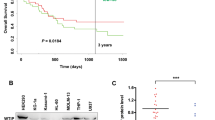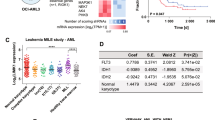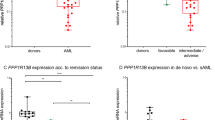Abstract
p73, the homologue of p53, is a nuclear protein whose ectopic expression, in p53+/+ and p53−/− cells, recapitulates the most well-characterized p53 effects, such as growth arrest, apoptosis and differentiation. Unlike p53, which is mutated in half of human cancers, p73 is rarely mutated. However, altered expression of the p73 gene has been reported in neuroblastoma, lung cancer, prostate cancer and renal cell carcinoma. To investigate the potential involvement of p73 in acute myeloid leukemias (AMLs), we analyzed 71 samples from AML patients for the expression pattern of N-terminal transactivation-p73α (TA-p73α), its spliced isoforms and N-terminal-deleted-p73 transcripts (ΔN-p73). We detected p73 gene expression in AML irrespective of FAB (French–American–British) subtypes. Notably, the analysis of ΔN-p73 expression, which has been reported to inactivate both p53 and p73 antitumor effects, revealed a rather peculiar pattern. In fact, ΔN-p73 transcript and protein were detectable in 27/28 (96.4%) cases of M0, M1, M2, M4, M5 and M6 AML and in 13/41 (31.7%) cases of PML-RARα-positive M3 AML (P<0.01). Thus, the distinct gene expression profile of p73 further supports the notion that acute promyelocytic leukemia is a biologically different subset of AML.
This is a preview of subscription content, access via your institution
Access options
Subscribe to this journal
Receive 12 print issues and online access
$259.00 per year
only $21.58 per issue
Buy this article
- Purchase on Springer Link
- Instant access to full article PDF
Prices may be subject to local taxes which are calculated during checkout




Similar content being viewed by others
References
Kaghad M, Bonnet H, Yang A, Creancier L, Biscan JC, Valent A et al. Monoallelically expressed gene related to p53 at 1p36, a region frequently deleted in neuroblastoma and other human cancers. Cell 1997; 90: 809–819.
Arrowsmith CH . Structure and function in the p53 family. Cell Death Differ 1999; 6: 1169–1173.
Chi S-W, Ayed A, Arrowsmith CH . Solution structure of a conserved C-terminal domain of p73 with structural homology to the SAM domain. EMBO J 1999; 18: 4438–4445.
De Laurenzi V, Catani VM, Terrinoni A, Corazzari M, Melino G, Costanzo A et al. Additional complexity in p73: induction by mitogens in lymphoid cells and identification of two new splice variants epsilon and zeta. Cell Death Differ 1999; 6: 389–390.
Ueda Y, Hijikata M, Takagi S, Chiba T, Shimotohno K . New p73 variants with altered C-terminal structures have varied transcriptional activities. Oncogene 1999; 18: 4993–4998.
De Laurenzi V, Costanzo A, Barcaroli D, Terrinoni A, Falco M, Annicchiarico-Petruzzelli M et al. Two new p73 splice variants, gamma and delta, with different transcriptional activity. J Exp Med 1998; 188: 1763–1768.
Scaruffi P, Casciano I, Masiero L, Basso G, Romani M, Tonini GP . Lack of p73 expression in mature B-ALL and identification of three new splicing variants restricted to pre B and C-ALL indicate a role of p73 in B cell ALL. Leukemia 2000; 14: 518–525.
Zaika A, Kovalev S, Marchenko ND, Moll UM . Overexpression of the wild type p73 gene in breast cancer tissues and cell lines. Cancer Res 1999; 59: 3257–3263.
Yang A, Walker N, Bronson R, Kaghad M, Oosterwegel M, Bonnin C et al. p73-deficient mice have neurological, pheromonal and inflammatory defects but lack spontaneous tumours. Nature 2000; 404: 99–103.
Kartasheva NN, Contente A, Lenz-Stoppler C, Roth J, Dobbelstein M . p53 induces the expression of its antagonist p73 Delta N, establishing an autoregulatory feedback loop. Oncogene 2002; 18: 4715–4727.
Grob TJ, Novak U, Maisse C, Barcaroli D, Luthi AU, Pirnia F et al. Human deltaNp73 regulates a dominant negative feedback loop for TAp73 and p53. Cell Death Differ 2001; 8: 1213–1223.
Zaika AI, Slade N, Erster SH, Sansome C, Joseph TW, Pearl M et al. DeltaNp73, a dominant-negative inhibitor of wild-type p53 and TAp73, is up-regulated in human tumors. J Exp Med 2002; 196: 765–780.
Nakagawa T, Takahashi M, Ozaki T, Watanabe Ki K, Todo S, Mizuguchi H et al. Autoinhibitory regulation of p73 by DeltaNp73 to modulate cell survival and death through a p73-specific target element within the DeltaNp73 promoter. Mol Cell Biol 2002; 22: 2575–2585.
Jost CA, Marin MC, Kaelin WG . p73 is a human p53 related protein that can induce apoptosis. Nature 1997; 389: 191–194.
Stiewe T, Pulzer BM . Role of p73 in malignancy: tumor suppressor or oncogene? Cell Death Differ 2002; 9: 237–243.
De Laurenzi V, Raschellà G, Barcaroli D, Annichiarico-Petruzzelli M, Ranalli M, Catani MV et al. Induction of neuronal differentiation by p73 in a neuroblastoma cell line. J Biol Chem 2000; 275: 15226–15231.
Fontemaggi G, Kela I, Amariglio N, Rechavi G, Krishnamurthy J, Strano S et al. Identification of direct p73 target genes combining DNA microarray and chromatin immunoprecipitation analyses. J Biol Chem 2002; 277: 43359–43368.
Kaelin J . The p53 family. Oncogene 1999; 18: 7701–7705.
Kong XT, Valentine VA, Rowe ST, Valentine MB, Ragsdale ST, Jones BG et al. Lack of homozygously inactivated p73 in single-copy MYCN primary neuroblastomas and neuroblastoma cell lines. Neoplasia 1999; 1: 80–89.
Kovalev S, Marchenko N, Swendeman S, LaQuaglia M, Moll UM . Expression level, allelic origin, and mutation analysis of the p73 gene in neuroblastoma tumors and cell lines. Cell Growth Differ 1998; 9: 897–903.
Stirewalt DL, Clurman B, Appelbaum FR, Willman CL, Radich JP . P73 mutations and expression in adult de novo acute myelogenous leukemia. Leukemia 1999; 13: 985–990.
Morena AR, Riccioni S, Marchetti A, Tartaglia Polcini A, Mercurio AM, Blandino G et al. Expression of β4 integrin subunit induces monocytic differentiation of 32D/v-Abl cells. Blood 2002; 100: 96–106.
Fontemaggi G, Gurtner A, Strano S, Higashi Y, Sacchi A, Piaggio G et al. The transcriptional repressor ZEB regulates p73 expression at the cross-road between proliferation and differentiation. Mol Cell Biol 2001; 24: 8461–8470.
Bennett JM, Catovsky D, Daniel MT, Flandrin G, Galton DA, Gralnick HR et al. Proposed revised criteria for the classification of acute myeloid leukemia. A report of the French–American–British Cooperative Group. Ann Intern Med 1985; 103: 620–625.
Grimwade D, Walker H, Oliver F, Wheatley K, Harrison C, Harrison G et al. on behalf of the Medical Research Council Adult and Children's Leukaemia Working Parties. The importance of diagnostic cytogenetics on outcome in AML: analysis of 1612 patients entered into the MRC AML 10 trial. Blood 1998; 92: 2322–2333.
Chomczynski P, Sacchi N . Single step method of RNA isolation by acid guanidium thiocyanate−phenol chloroform extraction. Anal Biochem 1987; 162: 156–159.
Van Dongen JJ, Macintyre EA, Gabert JA, Delabesse E, Rossi V, Saglio G et al. Standardized RT-PCR analysis of fusion gene transcripts from chromosome aberrations in acute leukemia for detection of minimal residual disease. Report of the BIOMED-1 Concerted Action: investigation of minimal residual disease in acute leukemia. Leukemia 1999; 13: 1901–1928.
Gabbianelli M, Sargiacomo M, Pelosi E, Testa U, Isacchi G, Peschle C . ‘Pure’ human hematopoietic progenitors: permissive action of basic fibroblast growth factor. Science 1990; 249: 1561–1564.
Tschan MP, Grob TJ, Peters UR, De Laurenzi V, Huegli B, Kreuzer KA et al. Enhanced p73 expression during differentiation and complex p73 isoforms in myeloid leukemia. Biochem Biophy Res Commun 2000; 277: 62–65.
Peters UR, Tschan MP, Krenzer KA, Baskaynak G, Lass U, Tobler A et al. Distinct expression patterns of the p53-Homologue p73 in malignant and normal hematopoiesis assessed by a novel real-time reverse transcription-polymerase chain reaction assay and protein analysis. Cancer Res 1999; 59: 4233–4236.
Strano S, Munarriz E, Rossi M, Cristofanelli B, Shaul Y, Castagnoli L et al. Physical and functional interaction between p53 mutants and different isoforms of p73. J Biol Chem 2000; 275: 29503–29512.
Levrero M, De Laurenzi V, Costanzo A, Sabatini S, Gong J, Wang JYJ et al. The p53/p63/p73 family of transcription factors: overlapping and distinct functions. J Cell Sci 2000; 113: 1661–1670.
Takagi S, Ueda Y, Hijikata M, Shimonoto K . Overproduced p73α activates a minimal promoter through a mechanism independent of its transcriptional activity. FEBS Lett 2001; 509: 47–52.
Strano S, Munarriz E, Rossi M, Cristofanelli B, Castagnoli L, Shaul Y et al. Physical interaction with Yes-associated protein (YAP) enhances p73 transcriptional activity. J Biol Chem 2001; 276: 15164–15173.
Basu S, Totty NF, Irwin MS, Sudol M, Downward J . Akt phosphorylates the Yes-associated protein, YAP, to induce interaction with 14-3-3 and attenuation of p73-mediated apoptosis. Mol Cell 2003; 11: 11–23.
Vossio S, Palescandolo E, Pediconi N, Moretti F, Balsano C, Levrero M et al. DN-p73 is activated after DNA damage in a p53-dependent manner to regulate p53-induced cell cycle arrest. Oncogene 2002; 21: 3796–3803.
Petrenko O, Zaika A, Moll UM . deltaNp73 facilitates cell immortalization and cooperates with oncogenic Ras in cellular transformation in vivo. Mol Cell Biol 2003; 23: 5540–5555.
Tallman MS, Nabhan CH, Feusner JH, Rowe JM . Acute promyelocytic leukemia: evolving therapeutic strategies. Blood 2002; 99: 759–767.
Longo L, Trecca D, Biondi A, Lo Coco F, Grignani F, Maiolo AT et al. Frequency of RAS and p53 mutations in acute promyelocytic leukemias. Leukemia Lymphoma 1993; 11: 405–410.
Trecca D, Longo L, Biondi A, Cro L, Calori R, Grignani F et al. Analysis of p53 gene mutations in acute myeloid leukemia. Am J Hematol 1994; 46: 304–309.
Gostissa M, Hofmann TG, Will H, Del Sal G . Regulation of p53 functions: let's meet at the nuclear bodies. Curr Opin Cell Biol 2003; 15: 351–357.
Hodges M, Tissot C, Howe K, Grimwade D, Freemont PS . Structure, organization, and dynamics of promyelocytic leukemia protein nuclear bodies. Am J Hum Genet 1998; 63: 297–304.
De Stanchina E, Querido E, Narita M, Davuluri RV, Pandolfi PP, Ferbeyre G et al. PML is a direct p53 target that modulates p53 effector functions. Mol Cell 2004; 13: 523–535.
Di Como CJ, Gaiddon C, Prives C . p73 Function is inhibited by tumor-derived p53 mutants in mammalian cells. Mol Cell Biol 1999; 19: 1438–1449.
Marin MC, Jost CA, Brooks LA, Irwin MS, O'Nions J, Tidy JA et al. A common polymorphism acts as an intragenic modifier of mutant p53 behaviour. Nat Genet 2000; 25: 47–54.
Gaiddon C, Lokshin M, Ahn J, Zhang T, Prives C . A subset of tumor-derived mutant forms of p53 down-regulate p63 and p73 through a direct interaction with the p53 core domain. Mol Cell Biol 2001; 21: 1874–1887.
Strano S, Fontemaggi G, Costanzo A, Rizzo MG, Monti O, Baccarini A et al. Physical interaction with human tumor derived p53 mutants inhibits p63 activities. J Biol Chem 2002; 277: 18817–18826.
Acknowledgements
We are grateful to William Kaelin Jr, Makoto Hijikata, Massimo Romani and Franco Mandelli for plasmids and helpful suggestions. We thank Sabrina Riccioni for technical assistance. This work has been supported by Associazione Italiana per la Ricerca sul Cancro (AIRC), Ministero della Salute-Italy, CNR-Italy, Ministero dell'Istruzione, dell'Università e della Ricerca (MIUR) and European Community.
Author information
Authors and Affiliations
Corresponding author
Rights and permissions
About this article
Cite this article
Rizzo, M., Giombini, E., Diverio, D. et al. Analysis of p73 expression pattern in acute myeloid leukemias: lack of ΔN-p73 expression is a frequent feature of acute promyelocytic leukemia. Leukemia 18, 1804–1809 (2004). https://doi.org/10.1038/sj.leu.2403483
Received:
Accepted:
Published:
Issue Date:
DOI: https://doi.org/10.1038/sj.leu.2403483
Keywords
This article is cited by
-
Clinical implications of the deregulated TP73 isoforms expression in cancer
Clinical and Translational Oncology (2018)
-
A new signaling cascade linking BMP4, BMPR1A, ΔNp73 and NANOG impacts on stem-like human cell properties and patient outcome
Cell Death & Disease (2018)
-
miRNA let-7c promotes granulocytic differentiation in acute myeloid leukemia
Oncogene (2013)
-
Functions, divergence and clinical value of TAp73 isoforms in cancer
Cancer and Metastasis Reviews (2013)
-
ΔN-p73 is a transcriptional target of the PML/RARα oncogene in myeloid differentiation
Cell Death & Differentiation (2007)



